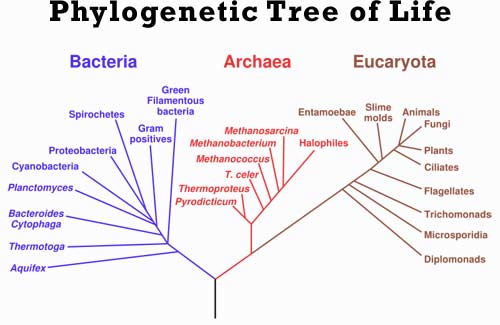|
For thousands of years, humans have divided all known life on earth into two “kingdoms”: plants and animals. As science developed, a “tree of life” was created, which placed all living things on a network of branches stemming from these two groups. Recent advances in our understanding of genetics and cell structure have yielded a revised version of the “tree of life.” Enjoy this brief overview of this newly sprouted tree while it lasts—who knows when it will morph again?
|
|
Branches on the Tree: If you had to divide all life on Earth into a few catagories, where would you start? In order to achieve this goal, scientists had to investigate the basic element of all life on earth: the cell. By exploring similarities and differences in cell structure and genetic information, scientists have honed in on the three bottom boughs on the tree of life from which all branches, staggering in their diversity, sprout.

While life on earth is incredibly varied, all living organisms rely on RNA (similar to DNA) to pass genetic information to the next generation. In 1977, Carl Woese analyzed the RNA of many life forms, and drew up a new tree of life based on his revolutionary discoveries! His tree has three main branches—Bacteria, Eucarya, and Archaea—by which which all life on earth can be classified. There are many kinds of phylogenetic trees of life, and this article will present the very basics!

- genetic material (DNA) is not contained in a nucleus
- bacterial cells are about 10 times smaller than Eukaryotic cells
- bacterial DNA form loops, while Eukaryote DNA form linear chromosomes
- single-celled organisms, which can congregate in clusters.
- common in every habitat on Earth
- evolved roughly 3.5 billion years ago

- name comes from the Greek word for "Ancient"
- can often tolerate extreme temperatures and acidity
- look like Bacteria, but genetically very different
- genetic material (DNA) is not contained in a nucleus
- cell walls and membranes contain different amino acids, sugars, etc
- therefore, drugs that kill Bacteria may have no effect on archaea
- share a common ancestor with Bacteria that lived 4 billion years ago
- among the oldest forms of life on Earth

- name comes from the Greek for "true nut"
- genetic info contained in nucleus
- cell membrain contains a cytoskeleton--a network of proteins that give the cell its shape.
- contain complex organelles (similar to organs, but on a cell's scale)
- Eucaryota show great diversity of form, but on a cellular level, they all share similar organization, biochemistry, and molecular biology.
- can have one or many cells.
- more closely related to Archaea than to Bacteria
|
